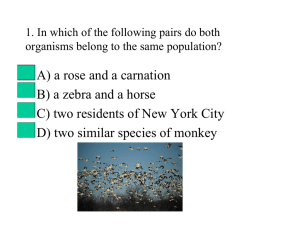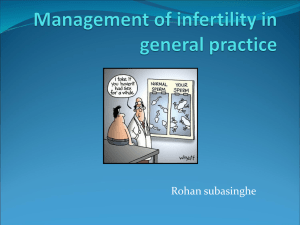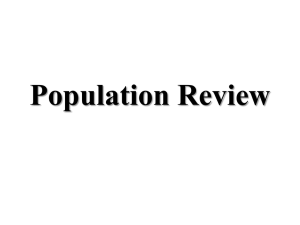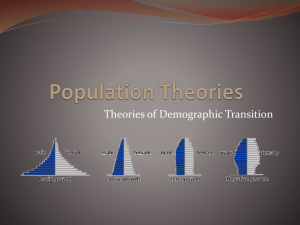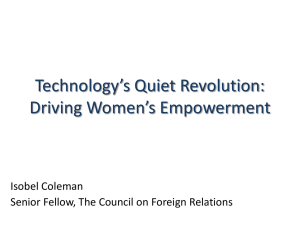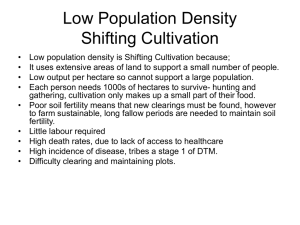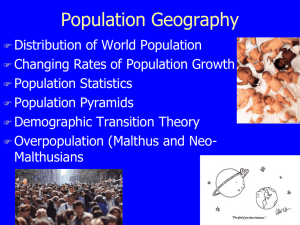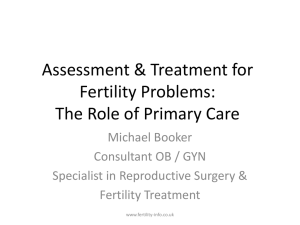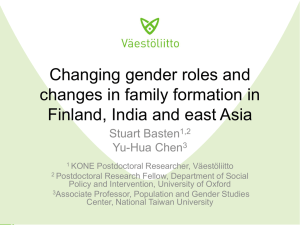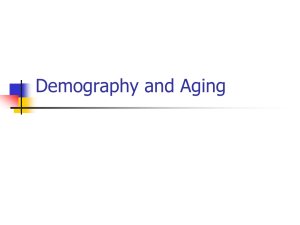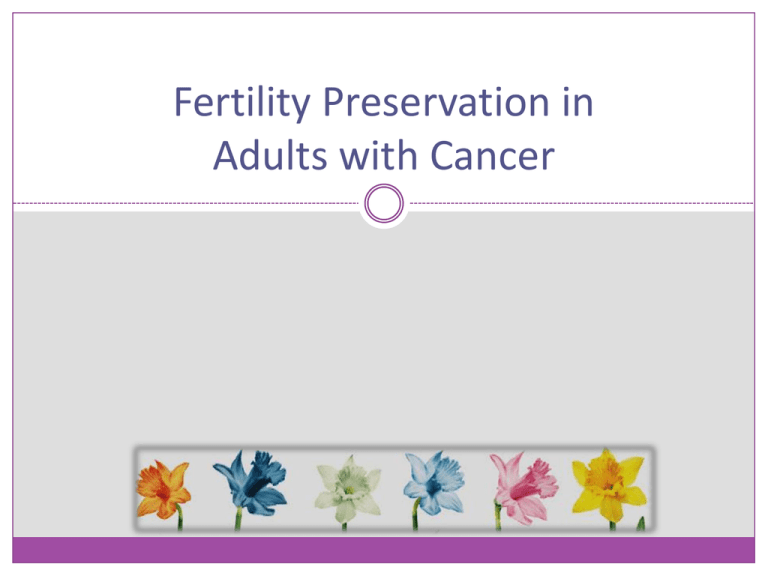
Fertility Preservation in
Adults with Cancer
Agenda
Background information
The effects of cancer treatments on fertility
Fertility preservation options
Referral and patient experience
Study conducted to explore attitudes, knowledge &
referring behaviors in Oncofertility among Ontario
physicians providing adult cancer care
Survey sent to 641 physicians in Ontario (medical
oncologists, radiation oncologists, gynecologic
oncologists & urologists)
152 physicians returned the survey - response rate of
23.7%
Results:
1. Majority of oncologists had positive attitudes but many did
not have current knowledge of cryopreservation
2.
Great majority did not have educational materials or
patient resources to facilitate discussion
3.
~25% did not know where to refer male cancer patients for
sperm banking; almost 50% rarely made a referral
4.
~ 45% did not know where to refer female cancer patients
for fertility preservation consultation; 70% rarely made a
referral
Results:
• Study conducted to survey sperm banking facilities and
fertility clinics of the provision of Oncofertility services
(commissioned by Canadian National Task Force on Adolescent and
Young Adult Cancer)
• Response rates:
• 59% (46/78) for oncology sperm banking services
• 59% (45/76) for female fertility preservation services
Results:
Results:
• Volume of oncofertility referrals was very low:
i.
For oncology sperm banking, only two responding facilities
had high referral volume (14-18/month); remaining received
1-6 referrals or rarely received any
ii. For female pre-cancer treatment fertility consultation, only
two responding facilities had high monthly referral volume
(approx. 15); the remaining received 1-7 referrals or rarely
received any
Fertility Preservation
The detrimental impact of cancer on fertility can be
severe
Having a history of cancer does not necessarily reduce
the desire to be a parent
Cancer survivorship rates are high and fertility as an
indicator of quality of life should not be overlooked
(Holzer, 2013; Schover et al., 1999; Yee et al., 2012)
Fertility Preservation
Diagnosis of cancer
Treatment plan
Assess fertility risk based
on treatment plan
R
I
S
K
Yes
Offer Fertility
Preservation
Referral
Inform of Risk
(Adapted from Fertile Hope, 2008)
Document
Discussion
R
I
S
K
R
I
S
K
?
No
Chemotherapy
Germinal epithelial cell damage
Depletion of spermatogonia
Leydig cell impairment
Testicular dysfunction
Testicular failure
(Adapted from Howell & Shalet, 2001 ; Jahnukainen et al., 2011)
Chemotherapy
Germinal epithelium of the testicle
occlusive
junctions
mature spermatid
spermatid
spermatocyte 2nd order
spermatocyte 1st order
spermatogonia
basal lamina
Sertoli cells
(Wikimedia Commons, 2006)
Chemotherapy
(Meistrich, 2009)
Chemotherapy
Destruction of growing follicles
Loss of primordial follicles
Loss of ovarian reserve
Ovarian atrophy
Ovarian failure
(Adapted from Holzer, 2013)
The human ovary, and potential targets of chemotherapeutic agents
(Morgan et al., 2012)
© The Author 2012. Published by Oxford University Press on behalf of the European Society of Human Reproduction and
Embryology. All rights reserved. For Permissions, please email: journals.permissions@oup.com
Table 4: Chemotherapy agents with high, intermediate and low gonadotoxic
impact in females and males
Prolonged azoospermia in males or amenorrhea in females
High risk
• Cyclophosphamide
• Ifosphamide
• Melphalan
• Busulfan
• Nitrogen mustard
• Procarbazine
• Chlorambucil
Intermediate risk
• Cisplastin with low cumulative dose
• Carboplatin with low cumulative dose
• Adriamycin
(Rodriguez-Wallberg & Oktay, 2014)
Low risk
• Treatment protocols for treatment
protocols without alkylating agents
• Bleomycin
• Actinomycin D
• Vincristine
• Methotrexate
• 5-Fluorouracil (5FU)
NB: FDA warning - Bevacizumab is
associated with ovarian failure
Radiotherapy
Direct damage to
testicles
Dose dependent;
total dose and
fractionation
schedule
(Adapted from Holzer, 2013)
Damage to hypothalamicpituitary axis
Age dependent
Radiation field
dependent
Radiotherapy
Direct damage to
ovaries
Dose dependent;
total dose and
fractionation
schedule
Damage to hypothalamicpituitary axis
Age dependent;
size of primordial
follicle pool
(Adapted from Ogilvy-Stuart & Shalet, 1993; Holzer, 2013)
Radiation field
dependent
Radiotherapy
Could also
affect
uterine
function:
Impaired
blood flow
(Adapted from Green et al., 2002; Holzer, 2013)
Endometrial
damage
Small uterine
volume
Miscarriage,
low birth
weight,
premature
delivery
(Wallace, 2011)
(* 100 × Gy = cGy)
*
(* 100 × Gy = cGy)
(Fertile Hope, 2008)
*
(* 100 × Gy = cGy)
(Fertile Hope, 2008)
*
(* 100 × Gy = cGy)
(Fertile Hope, 2008)
*
(Fertile Hope, 2008)
(* 100 × Gy = cGy)
(Fertile Hope, 2008)
*
*NB: FDA warning - Bevacizumab is associated with
ovarian failure
(Fertile Hope, 2008)
(Retrieved from http://oncofertility.northwestern.edu/assessing-ovarian-reserve-after-cancer-treatments)
Determining Risk
• Pretreatment fertility
potential
• Proposed treatment
(Ronn & Holzer, 2013)
Males & Females
“The impact of
cancer on fertility
The quantitative
impact of any
given cancer on a
young patient’s
fertility may be
difficult to define,
but detrimental
effects have
consistently been
demonstrated”.
Recovery
Men:
Some
degree of spermatogenesis may recover postchemo/ radiation but this may take up to 5–10 years
Often advised to wait 1 to 3 years post-treatment for
semen analysis
Women:
Amenorrhoea
may last 6-12 months or more postchemo/ radiation
Often advised to wait at least that long for ovarian
function assessment
(Howell & Shalet, 2001)
Pregnancy after Cancer
When?
Most
patients are advised to wait 2 years and this is
related to recurrence risk and possible risk of genetic
damage to sperm or eggs
Recurrence risk:
Pregnancy
itself it not known to cause or increase the risk
of recurrence, even after breast cancer
Pregnancy and ovarian failure:
Women
who have experienced iatrogenic ovarian failure
can still carry a pregnancy
(Green et al., 2002; Meistrich & Byrne, 2002)
Pregnancy after Cancer
Obstetrical risks:
Pregnancy
will be higher risk if pelvis radiated or posttrachelectomy
Risk to offspring:
Birth
defect rates or genetic diseases no higher in
children born to survivors
No
increased cancer risk in offspring of survivors unless
heritable caner
(Meistrich & Byrne, 2002)
Fertility Preservation
Options should be tailored to:
Patient’s age
Type of disease
Spread of the disease
Planned treatment
Time available
Single or partnered
(Adapted from Holzer, 2013)
Fertility Preservation
Gonadal protection:
Shielding
Ovarian transposition prior to local radiotherapy:
Reduces
dose to 5-15%
Patients <40
Laparoscopy
Location depends on the planned radiation
Does not protect against chemotherapy
(Holzer, 2013; Stroud et al., 2009; Wallace et al., 2005; Wo & Viswanathan, 2009)
Fertility Preservation
Suppression with GnRHa:
Hormonal
therapy for testicular suppression not
successful in preserving fertility and therefore not
recommended
Ovarian suppression is possibly helpful but there is
insufficient evidence to recommend
(Bedaiwy et al., 2011; Holzer, 2013)
Fertility Preservation
Cryopreservation:
Testicular and ovarian tissue
Cryopreservation
and reimplantation or grafting of
human testicular or ovarian tissue is recommended to
be performed only as part of clinical trials or approved
experimental protocols
Surgical
Only
(Loren et al.,2013)
option for prepubescents
Fertility Preservation
Cryopreservation:
Sperm banking
Most established technique for fertility preservation in men
Obtained through masturbated sample
May also be obtained through extraction procedures
Ideally performed prior to cancer treatment but as long as
there is sperm, can be done any time
Number of visits required varies
(Loren et al.,2013)
(Retrieved from savemyfertility.org)
Fertility Preservation
Cryopreservation:
Oocyte banking
Option if not partnered, ethical concerns re: embryo
banking
No longer experimental, PR dependent on age, approx 6-7%
per egg
Ovarian stimulation required
Ovarian stimulation associated with high E2 aromatase
inhibitor
2-6 weeks required
(Loren et al.,2013); Oktay, Cil & Bang, 2006; Oktay et al., 2006)
Fertility Preservation
Cryopreservation:
Embryo banking
Option
if partnered
Ovarian
stimulation required
stimulation associated with high E2
aromatase inhibitor
Ovarian
2-6
weeks required
(Loren et al.,2013; Oktay et al., 2006)
In Vitro Fertilization (IVF)
Cryobiology
Cryobiology
• Removal of water
• Additions of Cryoprotectants
(PROH, glycerol, DMSO)
• Slow cooling vs. Vitrification
• Storage periods of more than 40 years (J Assist Repro Genet Sept 2013) for
sperm and 11 years for embryos prior to pregnancies established have been
documented, but these records will be broken.
• Cost to freeze = $250 – 750
• Annual Storage = $200 - 600
AssistedConception
Conception Options
Assisted
Options
Embyro Adoption
Donor Sperm
Donor Oocytes
No Oocytes
No Sperm
After Biopsy
No Banked
Sperm
Sperm Recovered
Testicular Biopsy
Azospermic
Pre-treatment
Cryopreserved
Sperm
Frozen Oocytes
(Frozen Pre-treatment)
ART
IUI, IVF, ICSI
IVM, FET
Abnormal Sperm
Parameters
Frozen Embryos
(Created Pre-treatment)
Normal Ovarian
Function
Spermic
Normal Sperm
Function
No Ovarian
Function
No conception (12 mths)
Spontaneous Conception
Female Cancer Survivor
Male Cancer Survivor
Ovarian Tissue
Transplant
Age Related Fertility Rates
(In: Heffner, 2004)
IVF Success Rates
IVF/ICSI Cycles
40
Pregnancy
Live birth
% per cycle started
35
30
25
20
15
10
5
0
<35
6444
35-37
3530
38-40
3546
41-42
1844
43-44
623
>44
75
CARTR 2012
Barriers
Safety concerns
Hormones used for ovarian hyperstimulation
Treatment delay
Ethical concerns
Treatment of minors; experimental
Logistical issues
Lack of access to appropriate fertility centres
Financial issues
Disease often strains patient / family finances
Fertility preservation is very expensive
(Oncofertility in Ontario: A Presentation to Cancer Care Ontario, October 2013
Initial contact secretary
Information
Schedule
Appointment at the Centre for Fertility and Reproductive Health
Consultation (NP/ Fellow /MD)
TV Ultrasound (AFC, cycle stage)
Consultation review of all options, tailored options
C
O
U
N
S
E
L
L
I
N
G
GnRHa
Do nothing
3rd party
Oocyte
Embryo
Nursing consultation prn
Discuss and teach planned treatment
Treatment
Oocyte CP
Embryo CP
GnRH-a
Follow up
2nd collection
Luteal collection
US (AFC)
(Adapted from Holzer, 2013)
Additional cycle
Long term follow up
FSH AMH
Consultation
Counselling
T
R
E
A
T
I
N
G
P
H
Y
S
I
C
I
A
N
Fertility Preservation Costs
Time Frame
Immediate
Procedure
Sperm banking - subsequent samples $150
Surgical Sperm recovery – cost set by Urology and
Average Cost ($)
300.00
1600.00
subject to change
Future
Annual Sperm Storage
240.00
Sperm prep - Intra-uterine Insemination (IUI)
300.00
COH medications for in vitro fertilization (IVF)
3000.00
Monitoring; egg retrieval; lab procedures for IVF
7000.00
Intracytoplasmic sperm injection (ICSI)
1500.00
Fertility Preservation Costs
Time Frame
Immediate
Procedure
Average Cost ($)
Controlled ovarian Stimulation (COH) meds
3000.00
Oocyte pick up (OPU) procedure and egg freezing
4800.00
Oocyte pick up (OPU) procedure and embryo freezing
- includes intracytoplasmic sperm injection (ICSI) and first
5700.00
year of storage
Annual Egg / Embyro Storage
Future
360.00
Monitoring; egg / embryo thaw and transfer
1500.00
Intracytoplasmic sperm injection (ICSI)
1500.00
Embryo Freezing
650.00
Annual Embryo Storage
360.00
Power of Hope
Requirements
Income
Female
Male
<$100,000/year (single)
<$50,000/year (single)
<$125,000/year
(married/Common Law)
<$75,000/year
(married/common law)
Age
40 years old and younger
Treatment
Ca tx presents risk to fertility and has not begun prior to completion of
fertility treatment*
Identification
Valid Ontario Health Card (Canadian Citizen/Permanent Resident)
Reimbursement
1 time offer, must apply within 1 year of fertility preservation
procedure
Fertility Clinic
Power of Hope program member
*Requirements are taken into consideration upon contacting the Power of Hope Coordinator at Fertile Future.
www.fertilefuture.ca
Wish List
1)
Better education of oncology health care providers re:
importance of fertility discussion with all individuals of
childbearing age
2)
Universal access for young patients with cancer to fertility
preservation
3)
Funding of fertility preservation by MOHLTC (analogous to, for
example, post-mastectomy reconstruction)
(Oncofertility in Ontario: A Presentation to Cancer Care Ontario, October 2013
Resources
American Society of Clinical Oncology: clinical tools and
resources - http://www.asco.org/quality-guidelines/fertility-preservationpatients-cancer-american-society-clinical-oncology
Canadian Fertility & Andrology Society: Clinical Practice
Guideline - Fertility Preservation In Reproductive Age Woman Facing
Gonadotoxic Treatments
Cancer Knowledge
network - cancerkn.com
Fertile Future: information and support for cancer patients and
oncology professionals - www.fertilefuture.ca
Fertile Hope:
fertilehope.org
risk
Network:
calculator,
information,
print
referral
materials
-
Take Home Messages
• Cancer survivorship rates are high
• Cancer and its treatment can lead to infertility or sterility
• Fertility is an important aspect of quality of life for many people
• Resources for patients do exist and should be utilized
Questions/Comments?
References
Abrol K, Tonelli M, Yee S, Dwyer C & Liu K. (2009). CFAS Abstract: Female Oncology Patients and Fertility
Preservation: One Fertility Centre’s Experience.
American Society of Clinical Oncology (ASCO). (2013). Fertility Preservation for Patients With Cancer: American
Society
of
Clinical
Oncology
Clinical
Practice
Guideline
Update.
Retrieved
from
http://jco.ascopubs.org/content/early/2013/05/24/JCO.2013.49.2678.full.pdf+html.
Bedaiwy MA, Abou-Setta AM, Desai N, et al. (2011). Gonadotropin-releasing hormone analog cotreatment for
preservation of ovarian function during gonadotoxic chemotherapy: a systematic review and meta-analysis. Fertil
Steril, 95:906-14.
Brydøy M, Fossa SD, Dahl O & Bjøro D. (2007). Gonadal dysfunction and fertility problems in cancer survivors. Acta
Oncologica; 46: 480-89.
Canadian Cancer Society’s Advisory Committee on Cancer Statistics. Canadian Cancer Statistics. (2013). Toronto, ON:
Canadian Cancer Society. Retrieved from
http://www.cancer.ca/~/media/cancer.ca/CW/cancer%20information/cancer%20101/Canadian%20cancer%20statisti
cs/canadian-cancer-statistics-2013-EN.pdf
Canadian Fertility & Andrology Society (CFAS). (2014). Clinical Practice Guideline: Fertility Preservation In
Reproductive Age Woman Facing Gonadotoxic Treatments. Published online for members only.
De Vos M, Devroey P & Fauser BC. (2010). Primary Ovarian Insufficiency. Lancet, 376; 911-21.
Fertile Hope. (2008). Cancer & Fertility: Fast Facts for Reproductive Professionals. [PDF document]. Retrieved from
http://www.fertilehope.org/uploads/pdf/FH_RP_FastFacts_08.pdf.
References
Green DM, Whitton JA, Stovall M, Mertens AC, Donaldson SS, Ruymann FB, Pendergrass TW & Robison LL. (2002).
Pregnancy outcome of female survivors of childhood cancer: a report from the Childhood Cancer Survivor Study. Am J
Obstet Gynecol, 187 (4): 1070–1080.
Heffner LJ. (2004). Advanced maternal age–how old is too old? N Engl J Med, 351:1927-1929.
Holzer H. (2013). Fertility Preservation for Cancer Patients: Building the Bridges. [PDF document]. Retrieved from
http://saac.chu-sainte-justine.org/pages/14%20Hananel%20Holzer.pdf.
Howell SJ & Shalet SM. (2001). Testicular function following chemotherapy. Human Reproduction Update, 7(4), 363369.
Jahnukainen K, Ehmcke J & Schlatt S. (2011). Testicular function and fertility preservation in male cancer patients.
Best Practice & Research Clinical Endocrinology & Metabolism , 25(2): 287–302.
Loren AW, Mangu PB, Nohr Beck L, Brennan L, Magdalinski AJ, Partridge AH, Quinn G, Wallace WH, and Oktay K.
(2013). Fertility Preservation for Patients With Cancer: American Society of Clinical Oncology Clinical Practice
Guideline Update. J Clin Onc, 31:1-12.
Meistrich ML. (2009). Male Gonadal Toxicity. Pediatr Blood Cancer. 53 2): 261–266.
Meistrich ML & Byrne J. (2002). Genetic Disease in Offspring of Long-Term Survivors of Childhood and Adolescent
Cancer Treated with Potentially Mutagenic Therapies. Am J Hum Genet, 70(4): 1069–1071.
Morgan S, Anderson RA, Gourley C, Wallace WH & Spears N. (2012). How do chemotherapeutic agents damage the
ovary? Human Reproduction Update, 5(18): 525–535.
Ogilvy-Stuart AL. & Shalet SM. (1993). Effect of radiation on the human reproductive system. Environ Health Perspect,
101(Suppl 2): 109–116.
Oktay K, Cil AP & Bang H. (2006). Efficiency of oocyte cryopreservation: A meta-analysis. Fertil Steril 86:70-80.
References
Oktay K, Hourvitz A, Sahin G, et al. (2006). Letrozole reduces estrogen and gonadotropin exposure in women with
breast cancer undergoing ovarian stimulation before chemotherapy. J Clin Endocrinol Metab 91:3885-3890.
Rodriguez-Wallberg KA. & Oktay K. (2014). Fertility preservation during cancer treatment: clinical guidelines . Cancer
Management and Research,6: 105–117.
Ronn R & Holzer H (2013). Oncofertility in Canada: the impact of cancer on fertility. Curr Oncol; 20(4): e338–e344.
Schover LR, Rybicki L, Martin BA & Bringelsen KA. (1999). Having children after cancer: a pilot survey of survivors’
attitudes and experiences. Cancer, 86, 697-709.
Selk A, Belej-Rak T, Shapiro H, Greenblatt E. (2009). Use of an oncology sperm bank: a Canadian experience. Can
Urol Assoc J, 3(3): 219–222.
Stroud JS, Mutch D, Rader J, Powell M, Thaker PH & Grigsby PW. (2009). Effects of cancer treatment on ovarian
function. Fertil Steril, 92(2): 417-427.
Wallace WH. (2011). Oncofertility and preservation of reproductive capacity in children and young adults. Cancer,
117 (S10): 2301–2310.
Wallace WH, Thomson AB, Saran F & Kelsey TW. (2005). Predicting age of ovarian failure after radiation to a field that
includes the ovaries. Int J Radiat Oncol Biol Phys; 62:738-44.
Wikimedia Commons. (2006). [SVG file]. Retrieved from
http://en.wikipedia.org/wiki/File:Germinal_epithelium_testicle.svg.
Wo JY & Viswanathan AN. (2009). Impact of radiotherapy on fertility, pregnancy, and neonatal outcomes in female
cancer patients. Int J Radiat Oncol Biol Phys 73:1304-12.
Yee S, Abrol A, McDonald M, Tonelli M, Liu K. (2012). Addressing oncofertility needs: Views of female cancer patients
in fertility preservation. J Psych Oncology; 30(3): 331-46.
References
Yee S, Buckett W, Campbell S, Yanofsky R, Barr RD. (2012). A national study of the provision of oncofertility services to
female patients in Canada. J Obstet Gynaecol Can, 34(9):849-58.
Yee S, Buckett W, Campbell S, Yanofsky RA, Barr RD. (2013). A national study of
the provision of oncology sperm banking services among Canadian fertility clinics. Eur J Cancer Care (Engl), 22(4):4409.
Yee S, Fuller-Thomson E, Lau A, Greenblatt EM. (2012). Fertility preservation practices among Ontario oncologists. J
Cancer Educ, 27(2):362-8.

